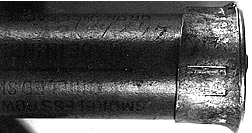TEST EXTRACTOR MARKS UNDER LOW PRESSURE
ON SHOTGUN CARTRIDGES
J K Sinha
Forensic Science International,27(1985)277-281(Elsevier)
Summary
The necessity for firing high pressure test rounds to imprint extractor marks on shotgun cartridges in cases involving improvised or non-standard locally made firearms has been obviated. A suitable method for obtaining desired extractor marks on shotgun cartridges under low pressure has been suggested.
The identification of fired shotgun cartridges by extractor marks is well known. The class and individual characteristic extractor marks imprinted by development of pressure, individual-ize the fired cartridge in respect of the suspect firearm. A high pressure is often required to imprint the extractor marks on the brass head of the shotgun cartridge. Therefore, a number of test rounds including oiled or heavy load may have to be fired to obtain proper test cartridges for comparison. This often poses a problem if the suspect firearm is an improvised non- standard locally made firearm which is common in India.Usually short barrelled locally made firearms designed to accommodate and fire 12-bore cartridges are used. These 12-bore pistols are manufactured crudely by using cheap materials. Sometimes, even water pipes are used for the barrel of the firearm. Besides using non-standard construction materials, these firearms also do not conform to standard specification so far as their dimensions are concerned. Therefore the firing of cartridges through such firearms may burst the barrel especially when heavy load cartridges which develop high pressure are fired. The present paper describes a criminal case in which the usual procedure adopted for imprinting extractor marks was modified. It obviated the necessity for developing high pressure.
The suspect firearm involved in the case was a home made pistol designed to fire 12 bore cartridges. It was required to identify the pistol in respect of a 12 bore 2 1/2 inch fired cartridge case found at the crime scene. The cartridge case had an almost separated base and the percussion cap was perforated. On examining the characteristic marks on the fired cartridge, it was found that the only identifying mark was that of the extractor on the cylindrical portion of brass head and partly on the paper wall (Fig1).

(Fig 1) Extractor marks on the crime cartridge
Such marks are usually imprinted when a high pressure is developed. Thus, for proper tests, firing of oiled or heavy load test cartridges was desirable. However, the home made pistol was unsuitable for firing high pressure rounds because the lever for closing the breech was loose and the cartridge head space was excessively high (Fig2).

(Fig 2) Loaded 12 bore country made pistol
showing excessive cartridge head space
Two cartridges of normal load were fired for test purposes, but did not produce the required extractor marks. A modified technique was thus adopted to form the required marks without resort to firing high pressure rounds. The surface on which the marks were to be imprinted was replaced by a softer metal than the brass of the cartridge. A thin lead piece was chosen for this. The dimension of the lead chosen for the purpose were such that it could cover length-wise nearly half of the cylindrical portion of the brass head and breadth-wise more than the width of the brass portion (Fig3).

(Fig 3) Extractor marks imprinted on the thin lead piece
placed on the cylindrical brass portion of the test cartridge
The required piece could conveniently be obtained by flattening an L.G. lead shot by hammering. The lead was then placed over the brass head of the live test cartridge and pressed by hand so as to make close contact. The cartridge with the lead cover was loaded in the chamber, keeping the lead just above the extractor. The gap between the extractor and the effective portion of the cartridge which would come in contact with the extractor on firing was thus reduced. Therefore, the pressure required for imprinting the extractor marks on the lead piece was expected to be even less than that developed on the firing of a normal load 2 1/2 inch cartridge. Even the pressure developed inside the cartridge before movement of the shot may be sufficient for the purpose. Cartridges having reduced shot charge have been found to be sufficient to develop the required pressure to imprint class and individual characteristic extractor marks on the thin lead piece in contact with the base of the cartridge. The shot charge may be reduced to half or even more depending upon the nature of marks and the firearm involved. Sometimes even the whole shot charge may be removed and the empty portion filled in with additional unfired or fired wads or cardboard pieces. In the case shot charge was reduced to almost one fourth and the empty portion was filled in with card board pieces. The pressure developed inside the cartridge was found to be sufficient to imprint the required class and individual characteristic extractor marks on the lead piece (Fig3b). The marks were examined and compared with the extractor marks present on the crime cartridge case and were found to be similar in their class and individual characteristics. This lead to the positive conclusion that the questioned fired cartridge case had been fired through the suspect pistol (Fig4).

(Fig 4) Striation matching of extractor marks
on crime cartridge and test lead piece.
The method can also be adopted for factory made firearms if the test live cartridge with the thin lead piece is not a tight fit in the chamber and it can be loaded easily. It may prove of great use if the required extractor marks are not imprinted even after firing a number of test rounds.
Return to Cartridge Identification
Cartridge Identification by Chamber Marks without test firing
Unusual Chamber Marks
Deceptive striations on fired cartridges
Consultation/Enquiry
:-- Mail to Author
RETURN TO SINHA'S
FORENSIC FIREARM PAGE |






